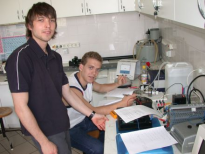Szegedi Tudományegyetem - Ahol tudás és szándék találkozik
 Beszerzési és Szolgáltatási Iroda (szolgáltatások)
Beszerzési és Szolgáltatási Iroda (szolgáltatások)
 Call for Proposal No. SZTE/2011/PSZ0150 Deadline for submision of offers extended!
Call for Proposal No. SZTE/2011/PSZ0150 Deadline for submision of offers extended!Offer No: SZTE/2011/PSZ0150
Deadline for submission of offers: 23.12.2011 (11.00 am)
Short specification of product:
Development of electrodes with shapes optimized for UV-preionized discharge-pumped KrF amplifiers of large cross-section.
One of the most important figure of merit of short-pulse excimer amplifiers is the so called momentarily-stored energy εm = εsat g l A, where εsat is the saturation energy density, g is the gain coefficient, l and A are the length and cross-section of the active medium, respectively. For most practical cases εm, however, is only a small fraction of the overall optical energy (ε) connected by the εm/ε ≈ τ/T equation (where τ is the storage time of excimers, T is the pumping time).
When developing charging schemes ideally suited for short-pulse excimer amplifiers, the great challenge is to minimize the pumping time (T) and to maximize εm. Since gl is limited by the amplified spontaneous emission, for a given value of εsat, the latter requirement is equivalent to maximize the cross-section (A). On the other hand this cross-section has to be pumped as homogenously as possible to get uniform beam distribution and minimum phase distortion.
Electron beam pumping is suitable for homogenous pumping of large cross-sections, however at the expense of increased complexity, operational cost, reduced lifetime and repetition rate. From these points of view discharge pumping is much more favourable and can realize the shortest pumping times, however the maximum – homogeneously pumped – cross section is limited and has proven to be critically dependent on the pumping conditions, including the pumping geometry (geometry of preionization and of the electric field).
Former extensive research and development activity was concentrated on the optimization of the preionization and of the pumping electric pulse (to minimize optical distortion and filamentation of the discharge). Since the normally used off-axis amplification relaxes the requirements for the homogeneity of the active medium, less emphasis was put on the cross-sectional homogeneity of the energy deposition in the discharge. Later considerations proved, that homogeneous energy deposition is also important when the spatially integrating off-axis amplification scheme is used; since homogeneous excitation is the only way to reach the maximum gl product over large cross-section (A), which determines the momentarily stored energy (εm).
Spatial distribution of the energy deposition in the discharge is primarily dependent on the distribution of the electric field between the electrodes, which is determined mainly by the shape of the electrodes, and also influenced by the surrounding charging circuit and by the dynamic effect of the magnetic field. In case of the practically preferred UV spark-preionization, the energy deposition is strongly modified by the spatially different level of preionization intensity, since the absorption length of preionization is comparable to or less than the size of the discharge section.
These “modifying” effects must be considered in UV preionized, fast, discharge pumped lasers, by applying special electrode shapes. It means, that for the realization of homogeneous energy deposition it is not enough to apply electrodes having a shape of producing homogeneous (static) electric field, but the electrode shape must be optimized through successive experimental study of the homogeneity of the discharge (which includes the hardly predictable effect of inhomogeneous UV preionization, the influence of the outer charging circuit and of the time dependent magnetic field).
Such a procedure is expensive and time consuming, unless some electrodes – of experimentally proven shapes – are available. It is known, that many, already existing excimer gain modules of limited discharge cross sections use UV spark preionization, where the former considerations/optimizations procedures are already made. The availability of such electrodes allows to measure simultaneously their shapes and the resulting spatial profile of the discharge. From these results – by applying some scaling procedures – homogeneous discharges of larger cross sections can be realized. This procedure is less expensive and expected to be realizable in a much shorter time compared to the other ways. The key point, however, is the availability of the corresponding electrodes.
The expenses of the purchase will be covered by TAMOP 4.2.1/B-09/1/KONV-2010-0005 Project
Billing address: University of Szeged, Dugonics tér 13, H-6720 Szeged, Hungary
Evaluation principles: the lowest price. Please indicate the total price including all the expenses.
Payment terms: payment of total price by transmittance within 30 days
Offers can be sumbitted: 1 original copy to be sent by mail to the address of University of Szeged, Directorate of Finance and Engineering (Szentháromság u. 34., IIIrd floor, office No. 35., H-6722 Szeged, Hungary) or in e-mail to the following e-mail address: kuczora.attila@gmf.u-szeged.hu in PDF file
On the envelope and in the heading of the documantation please indicate the Offer Number.
For further information please turn to the following contact persons:
Kálmán Ifkovics Head of Department e-mail: ifkovics.kalman@gmf.u-szeged.hu
Daniella Ashe technical support expphys@physx.u-szeged.hu
The official language of the procedure is Hungarian, but offers can also be submitted in English language. The Inviting Authority expects offers from suppliers that can guarantee a prompt delivery and have a stable financial background. The Inviting Authority reserves the right to request further information from candidates within 5 working days in writing . Request for further information will be sent to each candidate with a valid offer. Following the submission deadline, the Inviting Authority evaluates the offers and candidates are informed on the result with the least possible delay.
The Inviting Authority reserves the right to cancel the above offer procedure fully or partially, without any justification. The Inviting Authority is not liable for consequences resulted by the withdrawal.
This call for proposal is not to be considered as a contractual commitment undertaken by the Inviting Authority. The call and the full procedure are subject to the Inviting Authority’s internal regulations.Eredménytelen

Legolvasottabb
Rendezvénynaptár 
-
Karikó Katalin állandó kiállítás
január 06. - június 02. -
Matrica átvétel 2024/2025/2. félévre
február 10. - augusztus 30. -
CommuniTIK közösségi tér
március 31. - június 01. -
SZTE-Alma Mater – SZTE Lépjük meg! 2025
április 07. - június 08. -
SZTE Lépjük meg! kihívás
április 07. - június 08.
Gyorslinkek
Címkefelhő
14. Őszi Kulturális Fesztivál ,BTK ,Egyetemi Tavasz ,Egyetemi Élet ,Egyetemi élet ,Esemény ,Fókusz ,Irodalom ,JGYPK ,Kulturális Iroda ,Kultúra ,Kutatók Éjszakája 2009 ,Riport ,SZTE Kulturális Iroda ,SZTE Kultúrális Iroda ,Sport ,Szabadegyetem ,TIK ,TTIK ,ZMK ,


 Cikk nyomtatás
Cikk nyomtatás Link küldés
Link küldés Megosztás
Megosztás
